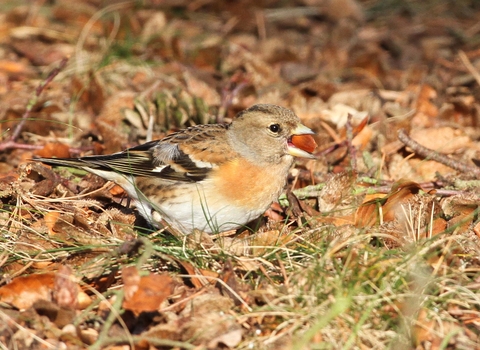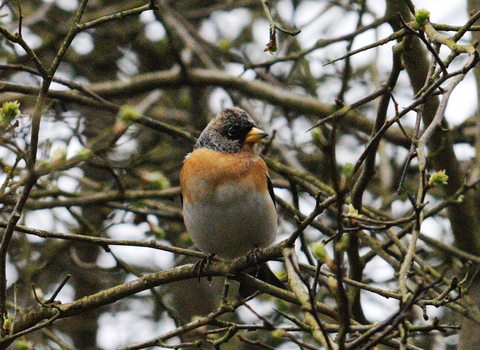
Female brambling ©Margaret Holland

Male brambling © Amy Lewis
Brambling
These winter visitors are close relatives of the chaffinch and can often be found in the same flocks, where their white rump and nasal calls give them away.
Scientific name
Fringilla montifringillaWhen to see
September to AprilSpecies information
Category
Statistics
Length: 14cmWingspan: 26cm
Weight: 24g
Common. Classified in the UK as Green under the Birds of Conservation Concern 5: the Red List for Birds (2021). Protected in the UK under the Wildlife and Countryside Act, 1981.
Habitats
About
Bramblings are brightly marked finches, with a beautiful rusty orange tint on the breast and shoulder, giving them a more colourful look than the browner hued female chaffinch.They spend the summer nesting in the forests of northern Europe and Asia, though pairs occasionally nest further south, including in northern Britain. At the end of the breeding season, they move south in huge flocks, looking for seeds and particularly beech mast to feed on. If there is a shortage of beech mast in southern Scandinavia, or if the snow is too heavy for birds to feed, huge numbers of brambling can move into the UK and central Europe for winter.
Bramblings are usually found in flocks, regularly joining up with chaffinches and other finches in places where plenty of food can be found. They're often found in woodlands, hedgerows and stubble fields, and will sometimes visit garden bird feeders.
How to identify
Bramblings are the same size and shape as a chaffinch, but have plenty of key differences to help tell them apart. In their summer breeding plumage, males have a glossy black head and back, but in winter the black feathers are hidden by pale fringes, giving the head and back a more mottled black and brown appearance. Females have a brown and grey head, with two distinct black lines running across the top of the head and down the nape.In both sexes, the breast and shoulder area is a rich, rusty orange colour (brighter and more extensive in males), compared to the reddish breast of a male chaffinch and the buff-grey of a female chaffinch. In winter, both male and female bramblings have a yellow bill, whereas chaffinches have a grey bill.
In flight, bramblings are easily spotted amongst a flock of chaffinches by their bright white rump. They also have rusty buff-coloured markings on their wings (white in chaffinch) and an almost all black tail (white tail sides in a chaffinch). Their nasal 'che-eep' call, with a notable rise in pitch, often gives away their presence.
